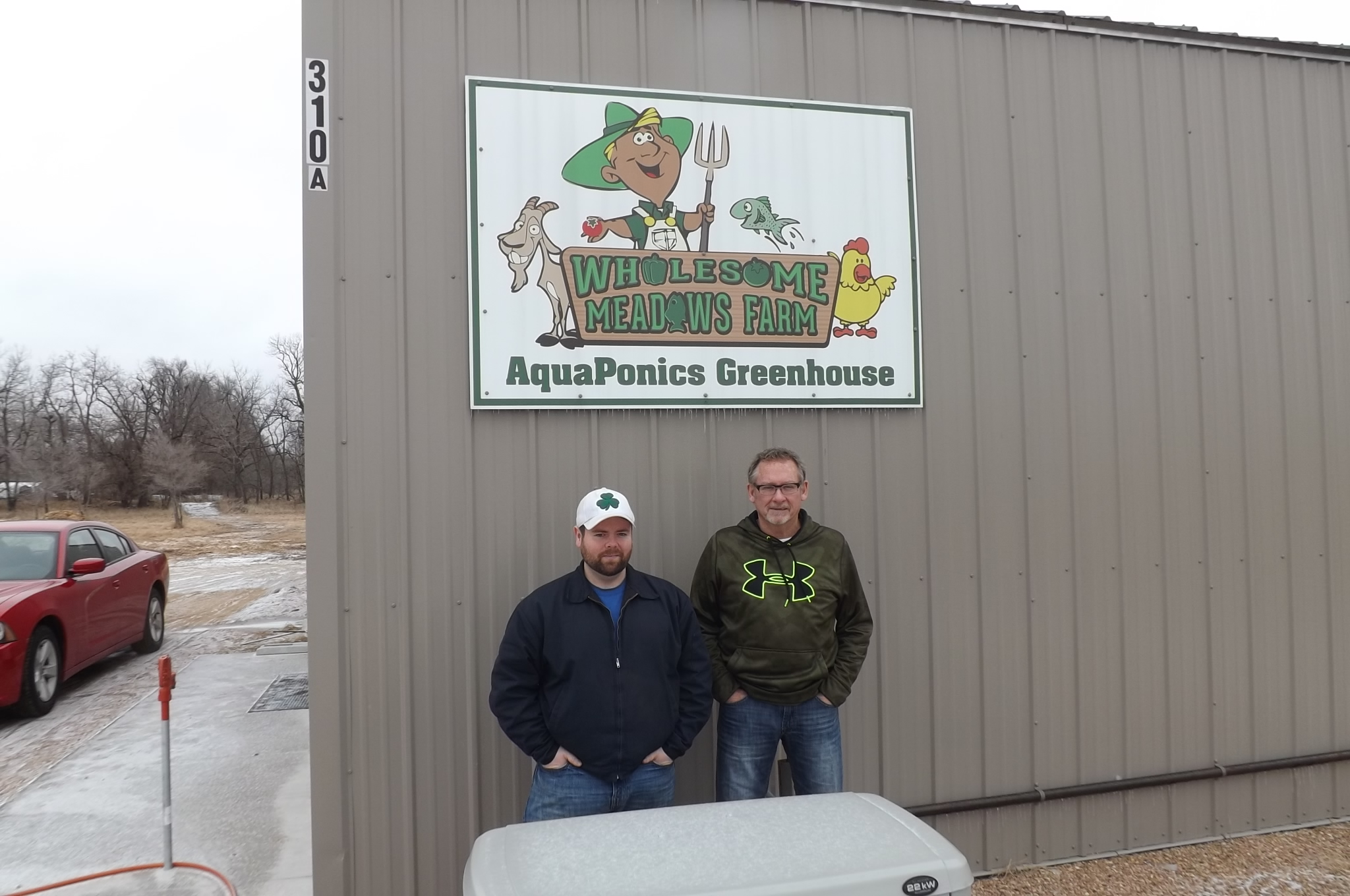After 20 years handling numerous operations for the company that owns both Sub and Stuff and Spaghetti Jacks restaurants, Gary Poulson opened his first Hog Wild Pit BBQ in 1998. After opening the seventh store in 2012, Poulson sold Hog Wild and went in search of his next venture.

Nearly thirty-five years in the restaurant business fostered his growing concern about our food supply in the U.S. He saw our current way of growing livestock with added hormones & antibiotics and producing crops with Roundup ready seeds and GMO’s (genetically modified organisms) as unsustainable and yearned to find a way to grow healthier food for his community. Poulsons family purchased ninety acres of land north of Hutchinson, and Wholesome Meadow Farms was born.
A friend of Poulson’s sent him a link to a website about Aquaponics, the science of growing plants with no soil, but using water from fish tanks that provides the fish waste to nourish the plants. At a certain size, the fish are also harvested, sold and replaced. Aquaponics has been in use in other countries for fifty years and is heavily researched at a university in the Virgin Islands. Poulson fell in love with the sustainability of the concept and began working with a company from Wisconsin whose owners actually studied aquaponics in the Virgin Islands and now specializes in helping growers plan and build Aquaponics systems.
In 2015, a 7200 square foot greenhouse was completed with a small area just inside dedicated to a retail store. A weather station on the roof provides constant weather data to computers that control and monitor heating, cooling and all other functions of the greenhouse and calls Poulson’s cell phone if any problems are detected. Inside the greenhouse is an onsite fish nursery where there are always two to three hundred Tilapia fingerlings waiting to replace larger fish when they are harvested. Poulson says several varieties of fish will work for aquaponics, but Tilapia fingerlings he gets from New Mexico are easiest for him to buy. A mini growing area utilizes circulated water from the four nursery tanks to grow leafy green plants.

Across the greenhouse, about 1,000 bigger Tilapia live in four large tanks that supply water for the main growing beds. From the four main fish tanks, water is gravity fed through a Clarification tank where solid fish waste is removed. Fish waste is high in ammonia which cannot be used by plants, so next the water flows through a mineralization tank and a bioreactor tank where beneficial bacteria convert the fish waste from ammonia into plant-friendly nitrates. Lastly the nitrate-laden water flows through the various growing beds where the only pump used in the system pumps it back into the fish tanks to begin its journey again. At 1 ½ to 2 pounds the Tilapia begin producing less waste and lose their effectiveness to the system, so at that weight they will be replaced with smaller fish from the nursery and harvested to be sold along with the vegetables.
To begin the planting process, seeds are planted in little cubes of material called Rockwool in special seeding tables. Each Rockwool cube is about the size of a piece of billiard chalk with a hole in the middle. One seed is planted in each cube and the cubes stay in the seeding table for about one week, where they begin receiving circulated water from the fish tanks. From the seeding tables they are placed in plastic channels called nutrient film techniques or NFT’s, through which nitrate rich water continues to flow.
After about two weeks in the NFT’s, plants are introduced into the appropriate growing beds. Leafy green plants are set into holes in two inch thick sheets of polystyrene in what are known as rafting beds; long four foot wide raised beds where the polystyrene sheets actually float on several inches of circulating fish-tank water, allowing the roots to grow down and feed directly from the water. Fruiting vegetables like tomatoes and peppers do not like their roots in water, so they are set into beds called media beds that are built at ground level and are filled with very porous rocks made from recycled glass. These media beds are flooded then drained twice daily, allowing the porous glass rocks to absorb nutrients from the water, in turn then making it possible for the plant roots to feed from the rocks.
As the greenhouse comes into full production, all plantings will be managed with the goal of eventually harvesting every day of the year. Plans are to grow about ten varieties of leafy greens, some micro greens which are becoming ever popular in restaurants and six or eight varieties of fruiting vegetables like tomatoes and peppers.
Future projects at Wholesome Meadow Farm are a roadside market in front of their property, a one-hundred-sixty tree orchard of apples, peaches and cherries utilizing an organic mulching system to create its own ecosystem in the soil, free-range chickens in moveable pens for both meat and eggs and possibly watermelons, cantaloupes and pumpkins.
Poulson’s son-in-law Shane Caley is presently his right hand man, and Wholesome Meadow Farm will soon become a family operation as both Poulson’s wife Tami and daughter Amber Caley also join the team. They are on schedule to begin planting in force the next couple weeks, so drive by the corner of 56th street and Monroe north of Hutchinson and check them out as a new way to Explore Kansas Outdoors.
Steve Gilliland, Inman, can be contacted by email at [email protected].

